Superposition of Load Groups#
Introduction#
This document provides a short introduction in the use of the program MAXIMA using load groups with an internal procedure of intermediate superpositions. The given generic example is only for demonstation purposes. The used design code is therefore not decisive. For comparison the second file includes the input definiton for the analog intermediate and final superpositons without load groups.
Theoretical Background#
It is mainly necessary in bridge construction that several variable loads are exclusive each other. E.g. for road bridges according to EN 1990 and EN 1991-2 the traffic loads are divided into load groups gr1 till gr5 which should not be simultaneously taken into account.
Objectives#
Generate the system inclusive the design code, materials, cross sections
Generate the actions with the task Action Manager or with the program SOFiLOAD using load goups for an variable action and its categories
Generate loads inside SOFiPLUS or with the program SOFiLOAD
Run linear analysis
Generate action combinations in program MAXIMA (SSD please use a TEDDY task, task ‘Define Combinations’ is not able to process load groups)
Generate superpositions
Alternative workflow for bridge design: use of program CSM, SSD task ‘CSM Bridge Design - Superpositioning’
Project Description#
In the given files a two span girder is generated.
Files:
two-span-girder_load-groups.dat use of the load groups
two-span-girder_intermediate-superposition.dat for comparison with intermediate superposition
Geometry#
A simple two-span girder, which has beam cuts every 1 m, is presented. The direction of gravity is the Z direction.
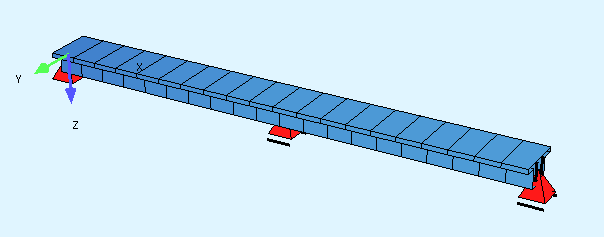
Materials#
Number |
Grade |
Notes |
|---|---|---|
1 |
C 30 (EN 1992) |
concrete fc = 30.0 MPa |
2 |
S 500B (EN 1992) |
reinforcing steel fy = 500 MPa, ft = 540 MPa |
Cross Section#
A simple T-beam is generated.
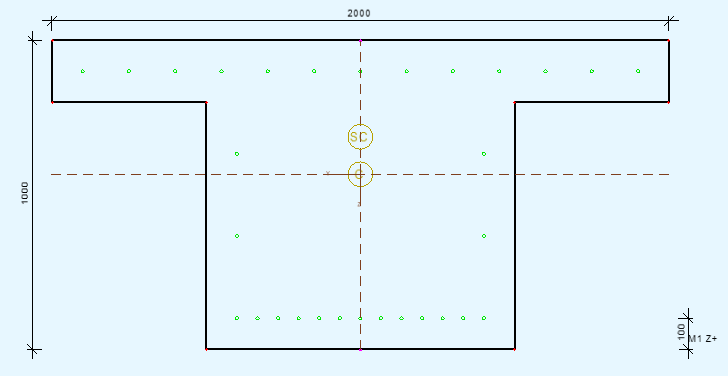
Actions and Load Cases#
Action and its Category |
Title |
Load Group |
Load Cases |
|---|---|---|---|
G_1 |
dead load, category 1, permanent |
11,12 |
|
GR |
action GR for variable traffic loads |
||
GR_1 |
dead load, category 1, exclusive within category 1 |
Q_1 (group 1) |
101 - 111 |
GR_2 |
dead load, category 2, exclusive within category 2 |
Q_1 (group 1) |
201 - 211 |
GR_3 |
dead load, category 3, exclusive within action GR |
Q_2 (group 2) |
301 - 311 |
GR_4 |
dead load, category 4, exclusive within action GR |
Q_3 (group 3) |
401 - 411 |
The SOFiLOAD input for the actions is:
+prog sofiload
HEAD Actions
ACT TYPE PART SUP GAMU GAMF PSI0 PSI1 PSI2 TITL
G_1 G PERM 1.35 1.00 1.00 1.00 1.00 'permanent'
$ Feature load groups -> in an action with categories
GR Q EXCL 1.50 0.00 0.90 0.60 0.40 'exclusive'
GR_1 Q_1 EXCL 1.50 0.00 0.90 0.60 0.40 'exclusive'
GR_2 Q_1 EXCL 1.50 0.00 0.80 0.50 0.30 'exclusive'
GR_3 Q_2 EXEX 1.50 0.00 0.90 0.60 0.40 'exclusive+category 1'
GR_4 Q_3 EXEX 1.50 0.00 0.90 0.60 0.40 'exclusive+category 2'
END
The actions and the loads are defined with the program SOFiLOAD. The printout of the table Actions inclusive the corresponding load cases is as follows:
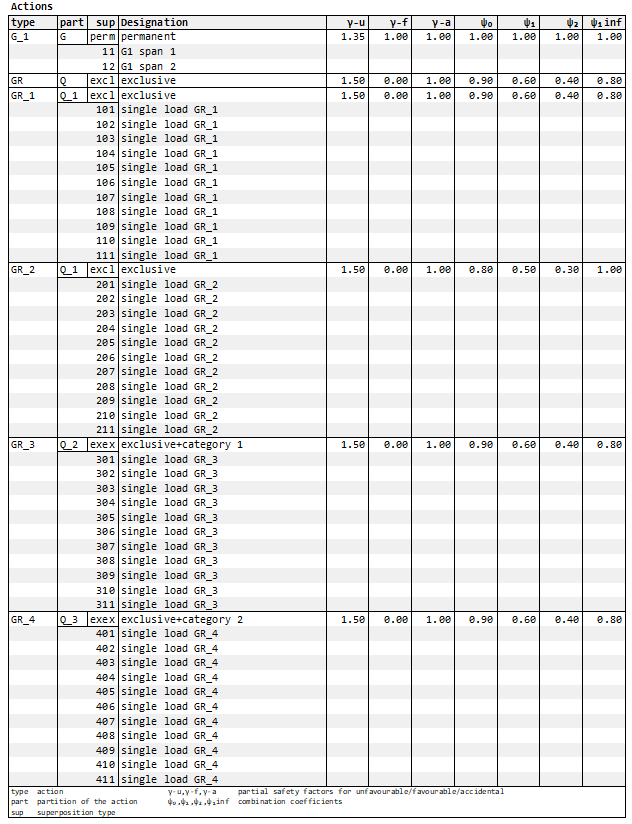
In the file two-span-girder_intermediate-superposition.dat for comparison purposes the categories for GR are not assigned to load groups and uses only PART Q - variable action.
Action Combination in Program MAXIMA#
In MAXIMA the necessary action combination and the desired superposition values have to be defined as usual. Here the combination DESI according to equation 6.10 EN 1990 is used. As superposition value the beam bending moment MY is defined.
The MAXIMA input is:
+prog maxima
HEAD Combination 10
ECHO LOAD,FACT FULL
COMB NO 10 EXTR desi TYPE desi BASE 3100
ACT G_1
ACT GR_1
LC -1
ACT GR_2
LC -1
ACT GR_3
LC -1
ACT GR_4
LC -1
SUPP 10 EXTR MAX ETYP BEAM TYPE MY FROM 105 X 0.00 $ FROM and X only for printout
END
As a second variant the combination 11 is shown in the file for demonstration. Here the explicit defined combination EXPL is used with action groups. It is the same defintion as for combination 10 with DESI.
Results of the Superposition#
The following scheme shows the procedure of the internal pre- and final superpositions:
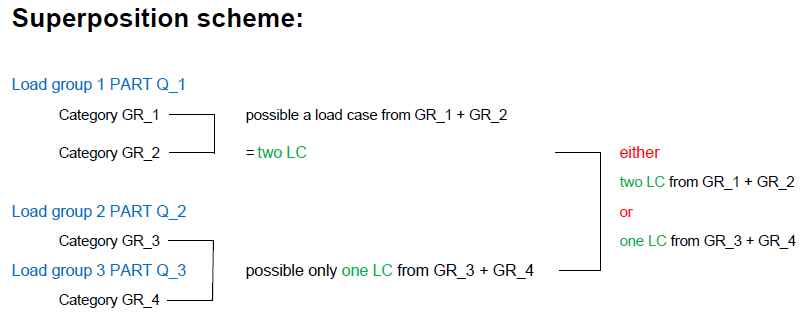
E.g. for the maximum bending moment in span 1 beam no. 105 position X 0.0 m the load cases 103 and 203 of the categories GR_1 and GR_2 of the load group 1 are decisive:
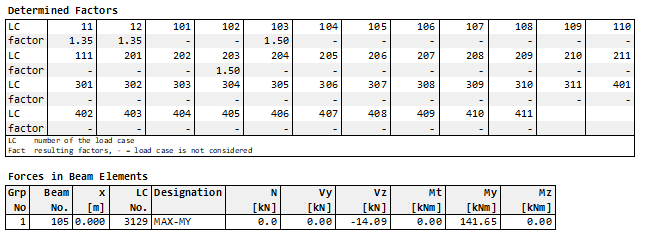
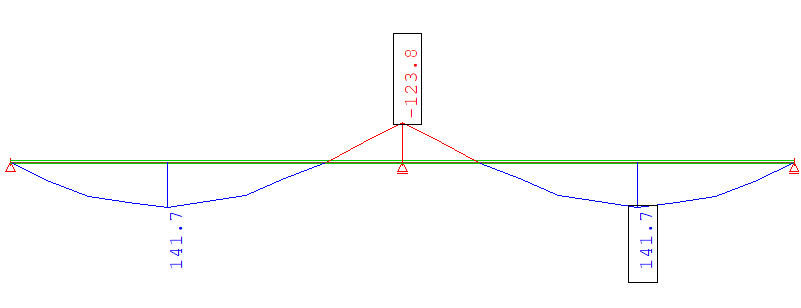
The results max MY of the comparison example with intermediate and final superpositon is equal:
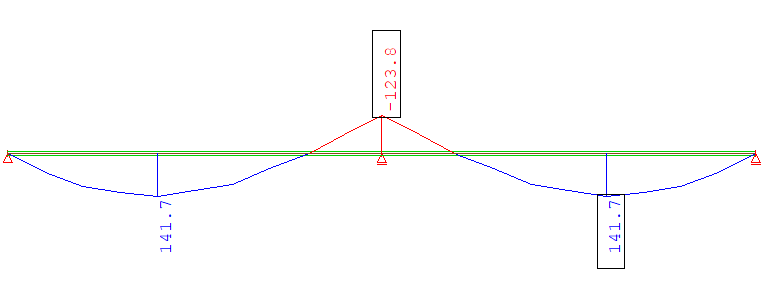
Loadcase Tracing#
In an own MAXIMA run with record TRAC it is possible to keep the loadcase tracing of the initial load cases for a superposition value at a specific structure position.
For the maximum bending moment My in beam no. 105 at start point the MAXIMA input is as follows:
+PROG MAXIMA
HEAD Loadcase tracing
TRAC LC 3129 ETYP BEAM ELEM 105 x 0[-] OPT 'IF'
END
The output table is then very compact:

Remarks#
In practice also other variable loads have to be considered, e.g. wind, snow, temperature. The dicision which action will be leading action is done in MAXIMA internally after processing of the load goups. This means that other variable actions can be added to the MAXIMA input.
For the workflow for superposition with load groups the use of the input with Teddy of the program MAXIMA is necessary. In the SSD task ‘Define Combinations’ actions which are assigned to load groups are not processed. The progam CSM uses load groups, because CSM generates MAXIMA input files.